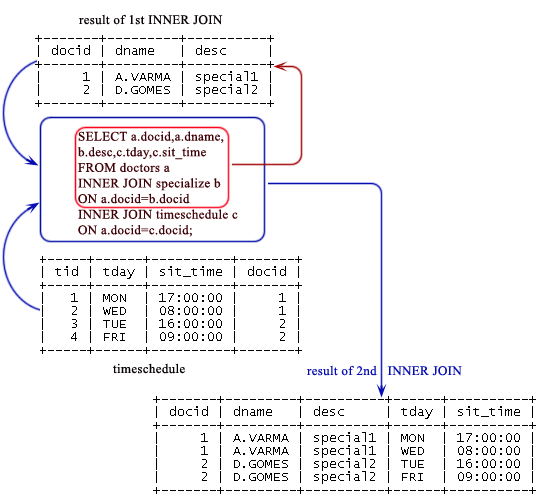
- SQLITE INNER JOIN EXPLAINED HOW TO
- SQLITE INNER JOIN EXPLAINED CODE
- SQLITE INNER JOIN EXPLAINED PASSWORD
SQLITE INNER JOIN EXPLAINED HOW TO
Here we will see how to work with SQLAlchemy ORM. So, orion_ could be the name (from the name column in the owners table) of this pet's owner.Īnd the ORM will do all the work to get the information from the corresponding table owners when you try to access it from your pet object.Ĭommon ORMs are for example: Django-ORM (part of the Django framework), SQLAlchemy ORM (part of SQLAlchemy, independent of framework) and Peewee (independent of framework), among others. This way, you could also have an attribute orion_cat.owner and the owner would contain the data for this pet's owner, taken from the table owners. These ORMs also have tools to make the connections or relations between tables or entities. And the value of that attribute could be, e.g. With an ORM, you normally create a class that represents a table in a SQL database, each attribute of the class represents a column, with a name and a type.įor example a class Pet could represent a SQL table pets.Īnd each instance object of that class represents a row in the database.įor example an object orion_cat (an instance of Pet) could have an attribute orion_cat.type, for the column type.
SQLITE INNER JOIN EXPLAINED CODE
ORMs ¶įastAPI works with any database and any style of library to talk to the database.Ī common pattern is to use an "ORM": an "object-relational mapping" library.Īn ORM has tools to convert (" map") between objects in code and database tables (" relations"). The FastAPI specific code is as small as always. Notice that most of the code is the standard SQLAlchemy code you would use with any framework.
SQLITE INNER JOIN EXPLAINED PASSWORD
OAuth2 with Password (and hashing), Bearer with JWT tokensĬreate SQLAlchemy models from the Base classĬreate Pydantic models / schemas for reading / returningĬustom Response - HTML, Stream, File, othersĪlternatives, Inspiration and Comparisons In this tutorial, you have learned how to use SQLite HAVING clause to specify the search condition for groups.Dependencies in path operation decorators HAVING length > 60000000 Code language: SQL (Structured Query Language) ( sql ) INNER JOIN albums ON albums.AlbumId = tracks.AlbumId The following statement queries data from tracks and albums tables using inner join to find albums that have the total length greater than 60,000,000 milliseconds. Try It SQLite HAVING clause with INNER JOIN example HAVING COUNT(albumid) BETWEEN 18 AND 20 ORDER BY albumid Code language: SQL (Structured Query Language) ( sql ) To find albums that have the number of tracks between 18 and 20, you use the aggregate function in the HAVING clause as shown in the following statement: SELECT We have referred to the AlbumId column in the HAVING clause. To find the numbers of tracks for the album with id 1, we add a HAVING clause to the following statement: SELECT To find the number of tracks for each album, you use GROUP BY clause as follows: SELECTĪlbumid Code language: SQL (Structured Query Language) ( sql ) We will use the tracks table in the sample database for demonstration. It only includes a group in the final result set if the evaluation is true. In this syntax, the HAVING clause evaluates the search_condition for each group as a Boolean expression.

Search_condition Code language: SQL (Structured Query Language) ( sql ) The following illustrates the syntax of the HAVING clause: SELECT Note that the HAVING clause is applied after GROUP BY clause, whereas the WHERE clause is applied before the GROUP BY clause.

If you use the HAVING clause, you must include the GROUP BY clause otherwise, you will get the following error: Error: a GROUP BY clause is required before HAVING Code language: JavaScript ( javascript ) Then the HAVING clause filters groups based on a specified condition. The GROUP BY clause groups a set of rows into a set of summary rows or groups. You often use the HAVING clause with the GROUP BY clause. The HAVING clause specifies a search condition for a group. SQLite HAVING clause is an optional clause of the SELECT statement. Summary: in this tutorial, you will learn how to use SQLite HAVING clause to specify a filter condition for a group or an aggregate.


 0 kommentar(er)
0 kommentar(er)
